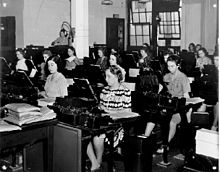
Back خرامة Arabic Hulkortmaskine Danish Lochkartenlocher German Perforadora de tarjetas Spanish Perforatrice de carte French Ծակատիչ Armenian キーパンチ Japanese Kekunci tebuk Malay Kaartponser Dutch Perfurador de cartão Portuguese



A keypunch is a device for precisely punching holes into stiff paper cards at specific locations as determined by keys struck by a human operator. Other devices included here for that same function include the gang punch, the pantograph punch, and the stamp. The term was also used for similar machines used by humans to transcribe data onto punched tape media.
For Jacquard looms, the resulting punched cards were joined together to form a paper tape, called a "chain", containing a program that, when read by a loom, directed its operation.[1]
For Hollerith machines and other unit record machines the resulting punched cards contained data to be processed by those machines. For computers equipped with a punched card input/output device the resulting punched cards were either data or programs directing the computer's operation.
Early Hollerith keypunches were manual devices. Later keypunches were electromechanical devices which combined several functions in one unit. These often resembled small desks with keyboards similar to those on typewriters and were equipped with hoppers for blank cards and stackers for punched cards. Some keypunch models could print, at the top of a column, the character represented by the hole(s) punched in that column. The small pieces punched out by a keypunch fell into a chad box,[2][3] or (at IBM) chip box, or bit bucket.
In many data processing applications, the punched cards were verified by keying exactly the same data a second time, checking to see if the second keying and the punched data were the same (known as two pass verification). There was a great demand for keypunch operators, usually women,[4] who worked full-time on keypunch and verifier machines, often in large keypunch departments with dozens or hundreds of other operators, all performing data input.
In the 1950s, Remington Rand introduced the UNITYPER, which enabled data entry directly to magnetic tape for UNIVAC systems. Mohawk Data Sciences subsequently produced an improved magnetic tape encoder in 1965, which was somewhat successfully marketed as a keypunch replacement. The rise of microprocessors and inexpensive computer terminals led to the development of additional key-to-tape and key-to-disk systems from smaller companies such as Inforex and Pertec.[5]
Keypunches and punched cards were still commonly used for both data and program entry through the 1970s but were rapidly made obsolete by changes in the entry paradigm and by the availability of inexpensive CRT computer terminals. Eliminating the step of transferring punched cards to tape or disk (with the added benefit of saving the cost of the cards themselves) allowed for improved checking and correction during the entry process. The development of video display terminals, interactive timeshared systems and, later, personal computers allowed those who originated the data or program to enter it directly instead of writing it on forms to be entered by keypunch operators.
- ^ Bell, T.F. (1895) Jacquard Weaving and Designing, Longmans, Green And Co.
- ^ Business automation, Volume 19, Hitchcock Pub. Co., 1972 p.38
- ^ Electronic Design, Volume 22, Issues 19-22, Hayden Pub. Co., 1974, pp.79, 195
- ^ IBM Archive: Keypunch operators, 1934, Stockholm
- ^ Aspray, W., ed. (1990). Computing before Computers. Iowa State University Press. p. 151. ISBN 0-8138-0047-1.
© MMXXIII Rich X Search. We shall prevail. All rights reserved. Rich X Search